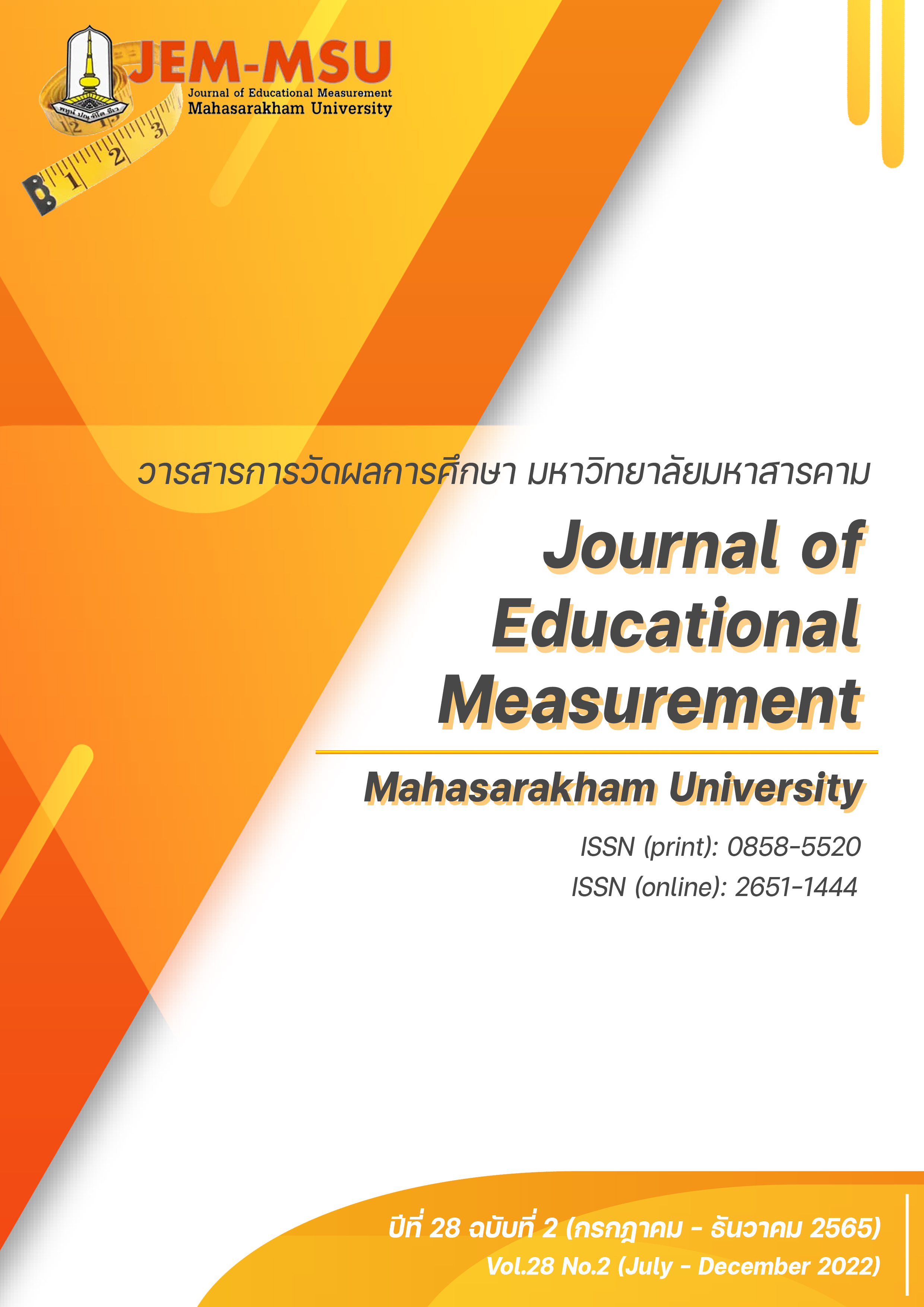การเปรียบเทียบผลของการบิดเบือนคำตอบระหว่างการใช้แบบวัดบุคลิกภาพห้าองค์ประกอบในรูปแบบบังคับเลือกกับรูปแบบมาตรประมาณค่าในสถานการณ์การคัดเลือก
Main Article Content
บทคัดย่อ
งานวิจัยกึ่งทดลองครั้งนี้มีวัตถุประสงค์เพื่อเปรียบเทียบผลของการบิดเบือนคำตอบระหว่างการใช้แบบวัดบุคลิกภาพห้าองค์ประกอบในรูปแบบบังคับเลือกและรูปแบบมาตรประมาณค่าในสถานการณ์คัดเลือก เครื่องมือที่ใช้ในการวิจัยประกอบด้วยแบบวัดบุคลิกภาพห้าองค์ประกอบในรูปแบบบังคับเลือกจำนวน 50 ข้อและแบบวัดบุคลิกภาพห้าองค์ประกอบในรูปแบบมาตรประมาณค่าจำนวน 100 ข้อ ซึ่งผ่านการตรวจสอบคุณภาพด้านความตรงและความเที่ยง โดยกลุ่มตัวอย่างที่ใช้ในการวิจัยเป็นนักศึกษาระดับชั้นปริญญาตรีจำนวน 100 คน ที่ได้จากการสุ่มตัวอย่างโดยใช้วิธีการสุ่มแบบกลุ่มแบบหลายขั้นตอน ผลการศึกษาพบว่า ในสถานการณ์คัดเลือก การใช้แบบวัดรูปแบบบังคับเลือกสามารถควบคุมการบิดเบือนคำตอบได้ดีกว่าการใช้แบบวัดรูปแบบมาตรประมาณค่า โดยสามารถควบคุมอัตราการเปลี่ยนแปลงคำตอบ อัตราการเฟ้อของคะแนน การเปลี่ยนแปลงของการจัดอันดับ และการเปลี่ยนแปลงผลการคัดเลือกได้ดีกว่า อย่างไรก็ตามการใช้แบบวัดรูปแบบบังคับเลือกยังไม่สามารถกำจัดอิทธิพลของการตั้งใจบิดเบือนคำตอบของผู้ตอบแบบวัดในสถานการณ์คัดเลือกได้อย่างสมบูรณ์
Article Details

อนุญาตภายใต้เงื่อนไข Creative Commons Attribution-NonCommercial-NoDerivatives 4.0 International License.
เนื้อหาและข้อมูลในบทความที่ลงตีพิมพ์ในวารสารการวัดผลการศึกษา มหาวิทยาลัยมหาสารคาม ถือเป็นข้อคิดเห็นและความรับผิดชอบของผู้เขียนบทความโดยตรง ซึ่งกองบรรณาธิการวารสาร ไม่จำเป็นต้องเห็นด้วย หรือร่วมรับผิดชอบใดๆ
บทความ ข้อมูล เนื้อหา รูปภาพ ฯลฯ ที่ได้รับการตีพิมพ์ในวารสารการวัดผลการศึกษา มหาวิทยาลัยมหาสารคาม ถือเป็นลิขสิทธิ์ของวารสารการวัดผลการศึกษา มหาวิทยาลัยมหาสารคาม หากบุคคลหรือหน่วยงานใดต้องการนำทั้งหมดหรือส่วนใดส่วนหนึ่งไปเผยแพร่ต่อหรือกระทำการใดๆ จะต้องได้รับอนุญาตเป็นลายลักษณ์อักษรจากวารสารการวัดผลการศึกษา มหาวิทยาลัยมหาสารคาม ก่อนเท่านั้น
เอกสารอ้างอิง
Allport, G. W. (1961). Pattern and growth in personality. Holt, Reinhart & Winston.
Barrick, M. R., Mount, M. K., & Judge, T. A. (2001). Personality and performance at the beginning of the new millennium: What do we know and where do we go next?. International Journal of Selection and assessment, 9(1‐2), 9-30.
Cao, M. (2016). Examining the fakability of forced-choice individual differences measures [Doctoral dissertation]. University of Illinois at Urbana-Champaign.
Costa, P. T., & McCrae, R. R. (1992). The five-factor model of personality and its relevance to personality disorders. Journal of Personality Disorders, 6(4), 343–359.
Cheung, M. W.L., & Chan, W. (2002). Reducing uniform response bias with ipsative measurement in multiple-group confirmatory factor analysis. Structural Equation Modeling, 9(1), 55-77.
Christiansen, N. D., Burns, G. N., & Montgomery, G. E. (2005). Reconsidering Forced-Choice Item Formats for Applicant Personality Assessment. Human Performance, 18(3), 267–307.
Heggestad, E. D., Morrison, M., Reeve, C. L., & McCloy, R. A. (2006). Forced-choice assessments of personality for selection: Evaluating issues of normative assessment and faking resistance. Journal of Applied Psychology, 91(1), 9–24.
Hontangas, P. D., Torre, J. D., Ponsoda, V., Leenen, I., Morillo, D., & Abad, F. J. (2015). Comparing traditional and IRT scoring of forced-choice tests. Applied Psychological Measurement, 39(8), 598-612.
Jackson, D. N., Wroblewski, V. R., & Ashton, M. C. (2000). The impact of faking on employment tests: Does forced choice offer a solution? Human Performance, 13(4), 371–388.
Khorramdel, L. (2014). The influence of different rating scales on impression management in high stakes assessment. Psychological Test and Assessment Modeling, 56(2), 154–167.
Martin, B. A., Bowen, C.-C., & Hunt, S. T. (2002). How effective are people at faking on personality questionnaires? Personality and Individual Differences, 32(2), 247–256.
Mueller-Hanson, R., Heggestad, E. D., & Thornton, G. C. III. (2003). Faking and selection: Considering the use of personality from select-in and select-out perspectives. Journal of Applied Psychology, 88(2), 348–355.
Satoshi Usami, A. Sakamoto, J. Naito, Y. abe. (2016). Developing Pairwise Preference-Based Personality Test and Experimental Investigation of Its Resistance to Faking Effect by item response model. International Journal of testing, 16, 288-309.
Salgado, J. F., Anderson, N., & Tauriz, G. (2015). The validity of ipsative and quasi‐ipsative forced‐choice personality inventories for different occupational groups: A comprehensive meta‐analysis. Journal of Occupational and Organizational Psychology, 88(4), 797–834.
Sjoberg, L. (2015). Correction for faking in self-report personality tests. Scandinavian journal of psychology, 56(5), 582-591.
Stark, S., Chernyshenko, O., & Drasgow, F. (2005). An IRT approach to constructing and scoring pairwise preference items involving stimuli on different dimensions: An application to the problem of faking in personality assessment. Applied Psychological Measurement, 29, 184- 201.
Stark, S. Chernyshenko, F. & Drasgow, A. White. (2012). Adaptive Testing with Multidimensional Pairwise Preference Items: Improving the efficiency of personality and other noncognitive assessment. Organizational Research Methods, 15(3), 463-487.
Office of the Education Council. (2020). State of specialized education management in Thailand 2017-2018: Personnel production. Prikwarn Graphic. (in Thai)


